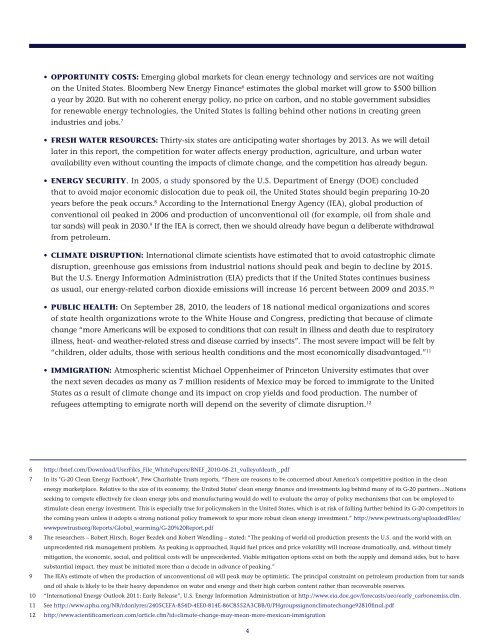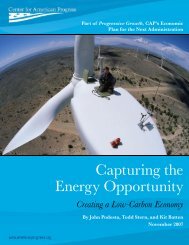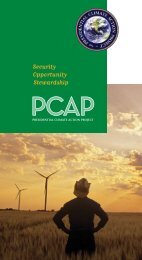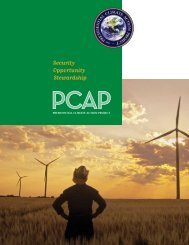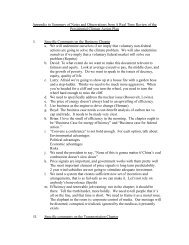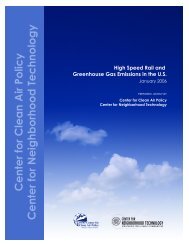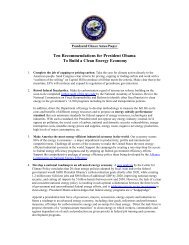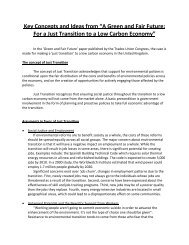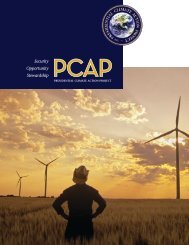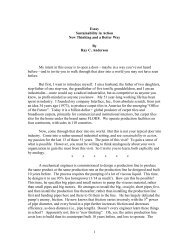The 2011 Plan - Presidential Climate Action Project
The 2011 Plan - Presidential Climate Action Project
The 2011 Plan - Presidential Climate Action Project
You also want an ePaper? Increase the reach of your titles
YUMPU automatically turns print PDFs into web optimized ePapers that Google loves.
OPPORTUNITY COSTS: Emerging global markets for clean energy technology and services are not waitingon the United States. Bloomberg New Energy Finance 6 estimates the global market will grow to $500 billiona year by 2020. But with no coherent energy policy, no price on carbon, and no stable government subsidiesfor renewable energy technologies, the United States is falling behind other nations in creating greenindustries and jobs. 7 FRESH WATER RESOURCES: Thirty-six states are anticipating water shortages by 2013. As we will detaillater in this report, the competition for water affects energy production, agriculture, and urban wateravailability even without counting the impacts of climate change, and the competition has already begun. ENERGY SECURITY. In 2005, a study sponsored by the U.S. Department of Energy (DOE) concludedthat to avoid major economic dislocation due to peak oil, the United States should begin preparing 10-20years before the peak occurs. 8 According to the International Energy Agency (IEA), global production ofconventional oil peaked in 2006 and production of unconventional oil (for example, oil from shale andtar sands) will peak in 2030. 9 If the IEA is correct, then we should already have begun a deliberate withdrawalfrom petroleum. CLIMATE DISRUPTION: International climate scientists have estimated that to avoid catastrophic climatedisruption, greenhouse gas emissions from industrial nations should peak and begin to decline by 2015.But the U.S. Energy Information Administration (EIA) predicts that if the United States continues businessas usual, our energy-related carbon dioxide emissions will increase 16 percent between 2009 and 2035. 10 PUBLIC HEALTH: On September 28, 2010, the leaders of 18 national medical organizations and scoresof state health organizations wrote to the White House and Congress, predicting that because of climatechange “more Americans will be exposed to conditions that can result in illness and death due to respiratoryillness, heat- and weather-related stress and disease carried by insects”. <strong>The</strong> most severe impact will be felt by“children, older adults, those with serious health conditions and the most economically disadvantaged.” 11 IMMIGRATION: Atmospheric scientist Michael Oppenheimer of Princeton University estimates that overthe next seven decades as many as 7 million residents of Mexico may be forced to immigrate to the UnitedStates as a result of climate change and its impact on crop yields and food production. <strong>The</strong> number ofrefugees attempting to emigrate north will depend on the severity of climate disruption. 126 http://bnef.com/Download/UserFiles_File_WhitePapers/BNEF_2010-06-21_valleyofdeath_.pdf7 In its "G-20 Clean Energy Factbook", Pew Charitable Trusts reports, “<strong>The</strong>re are reasons to be concerned about America’s competitive position in the cleanenergy marketplace. Relative to the size of its economy, the United States’ clean energy finance and investments lag behind many of its G-20 partners…Nationsseeking to compete effectively for clean energy jobs and manufacturing would do well to evaluate the array of policy mechanisms that can be employed tostimulate clean energy investment. This is especially true for policymakers in the United States, which is at risk of falling further behind its G-20 competitors inthe coming years unless it adopts a strong national policy framework to spur more robust clean energy investment.” http://www.pewtrusts.org/uploadedFiles/wwwpewtrustsorg/Reports/Global_warming/G-20%20Report.pdf8 <strong>The</strong> researchers – Robert Hirsch, Roger Bezdek and Robert Wendling – stated: “<strong>The</strong> peaking of world oil production presents the U.S. and the world with anunprecedented risk management problem. As peaking is approached, liquid fuel prices and price volatility will increase dramatically, and, without timelymitigation, the economic, social, and political costs will be unprecedented. Viable mitigation options exist on both the supply and demand sides, but to havesubstantial impact, they must be initiated more than a decade in advance of peaking.”9 <strong>The</strong> IEA’s estimate of when the production of unconventional oil will peak may be optimistic. <strong>The</strong> principal constraint on petroleum production from tar sandsand oil shale is likely to be their heavy dependence on water and energy and their high carbon content rather than recoverable reserves.10 “International Energy Outlook <strong>2011</strong>: Early Release”, U.S. Energy Information Administration at http://www.eia.doe.gov/forecasts/aeo/early_carbonemiss.cfm.11 See http://www.apha.org/NR/rdonlyres/2405CEFA-854D-4EE0-814E-86C8552A3CBB/0/PHgroupssignonclimatechange92810final.pdf12 http://www.scientificamerican.com/article.cfm?id=climate-change-may-mean-more-mexican-immigration4


